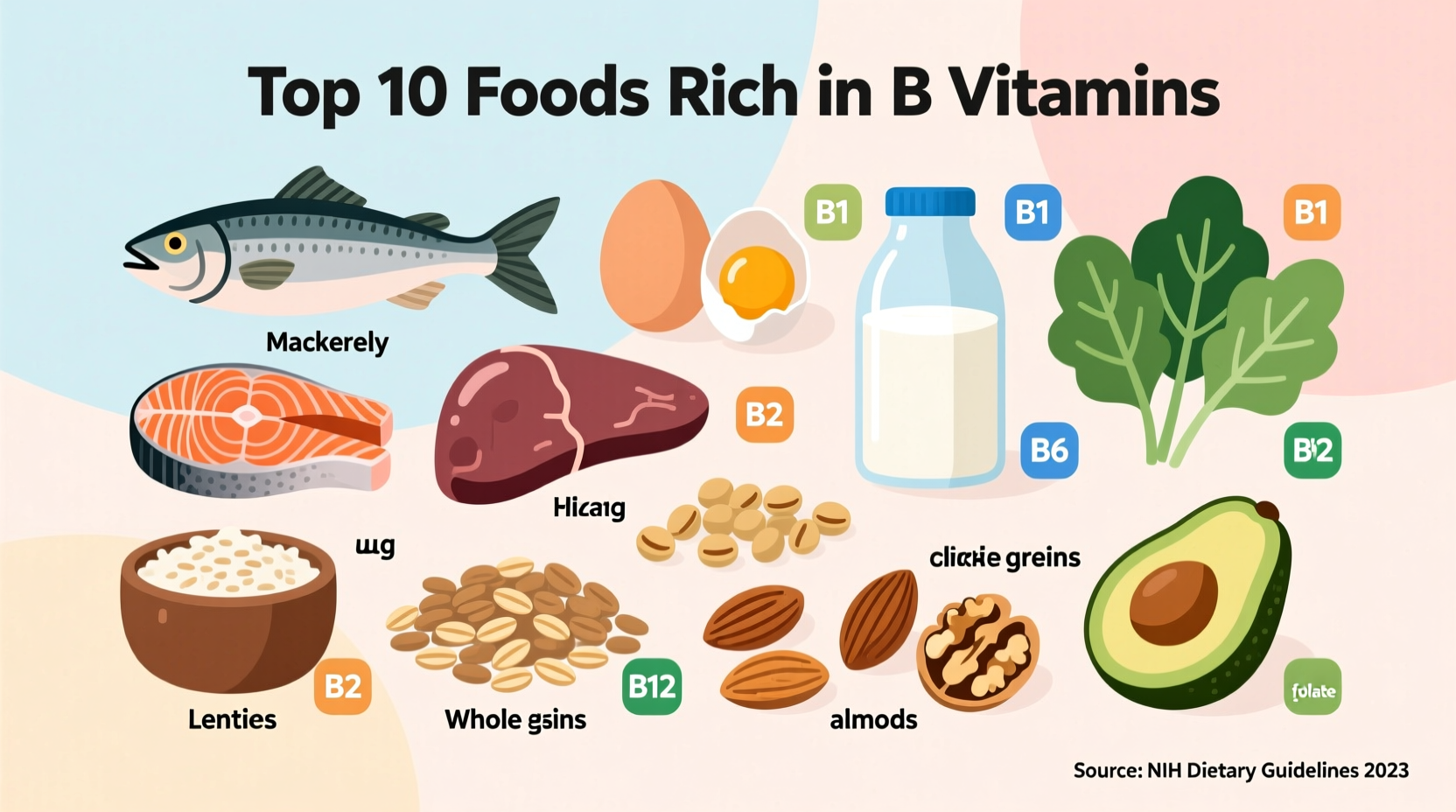Discover exactly which foods deliver each essential B vitamin, how much you need daily, and practical ways to incorporate these nutrient powerhouses into your meals. This evidence-based guide cuts through the confusion with scientifically verified information you can trust.
Why B Vitamins Are Your Body's Essential Team Players
Often overshadowed by flashier nutrients, the B vitamin complex works as an interconnected team supporting critical bodily functions. These water-soluble vitamins don't store well in your body, making daily intake crucial. Unlike popular belief, B vitamins do far more than just boost energy—they're vital for:
- Converting food into cellular energy (metabolism)
- Maintaining healthy brain function and mood regulation
- Supporting red blood cell formation and preventing anemia
- Preserving nerve function and cognitive health
- Facilitating DNA synthesis and cell repair
"Many people don't realize that each B vitamin has specialized roles, and deficiency in just one can disrupt your entire metabolic orchestra," explains nutrition researcher Dr. David Jenkins in the American Journal of Clinical Nutrition. This interdependence makes consuming a variety of B-rich foods essential.
Your Complete B Vitamin Food Reference Guide
Below we've organized the best food sources by specific B vitamin, based on USDA FoodData Central nutrient analysis. Understanding these distinctions helps you target your dietary choices effectively.
| B Vitamin | Top 3 Food Sources (per serving) | Key Functions |
|---|---|---|
| B1 (Thiamine) | Sunflower seeds, pork chops, black beans | Energy metabolism, nerve function |
| B2 (Riboflavin) | Organ meats, milk, mushrooms | Antioxidant protection, skin health |
| B3 (Niacin) | Tuna, chicken breast, peanuts | DNA repair, cholesterol management |
| B5 (Pantothenic Acid) | Mushrooms, avocados, eggs | Hormone production, stress response |
| B6 (Pyridoxine) | Chickpeas, salmon, potatoes | Neurotransmitter synthesis, immune function |
| B7 (Biotin) | Egg yolks, almonds, sweet potatoes | Metabolism of fats/carbs, hair/skin health |
| B9 (Folate) | Leafy greens, lentils, asparagus | Cell division, fetal development, homocysteine regulation |
| B12 (Cobalamin) | Liver, clams, fortified nutritional yeast | Nerve function, red blood cell formation, DNA synthesis |
Maximizing B Vitamin Absorption: What Most Guides Miss
Simply eating B vitamin-rich foods isn't enough—how you prepare and combine them dramatically impacts absorption. Research from Harvard T.H. Chan School of Public Health reveals these critical factors:
- Cooking methods matter: Boiling destroys up to 50% of water-soluble B vitamins, while steaming preserves 80-90%. The Harvard Nutrition Source confirms that microwaving with minimal water preserves B vitamins best.
- Fat-soluble pairing: B vitamins B2 and B3 absorb better with healthy fats. Try adding avocado to spinach salads for enhanced folate uptake.
- Avoid alcohol with meals: Even moderate alcohol consumption can reduce B1, B6, and B12 absorption by 30-50%, according to National Institutes of Health studies.
- Time your coffee: Consuming coffee within an hour of eating B vitamin-rich foods can inhibit absorption by up to 35%.

Special Dietary Considerations for Optimal B Intake
Different lifestyles require tailored approaches to B vitamin consumption. These evidence-based recommendations address specific needs:
For Vegetarians and Vegans
Plant-based diets often lack sufficient B12, which primarily exists in animal products. The Academy of Nutrition and Dietetics recommends:
- Fortified nutritional yeast (providing 100% of daily B12 in 2 tablespoons)
- Fortified plant milks and cereals
- Consider B12 supplementation (250-500 mcg daily) as deficiency risks increase over time
For Older Adults
After age 50, stomach acid production decreases, reducing B12 absorption from food by up to 70%. The National Institute on Aging suggests:
- Focusing on fortified foods rather than relying solely on animal sources
- Considering sublingual B12 supplements for better absorption
- Regular blood testing to monitor B12 status
During Pregnancy
Folate (B9) needs increase by 50% during pregnancy. The CDC emphasizes:
- Consuming 600 mcg DFE daily from both food and supplements
- Prioritizing cooked leafy greens over raw (cooking increases folate bioavailability by 20-30%)
- Avoiding excessive liver consumption due to vitamin A concerns
When Food Isn't Enough: Recognizing Deficiency Risks
Certain conditions may require medical intervention beyond dietary changes. The Mayo Clinic identifies these red flags:
- Persistent fatigue despite adequate sleep (possible B1, B2, B3 deficiency)
- Numbness or tingling in hands/feet (B6 or B12 deficiency)
- Mood changes like depression or irritability (B6, B9, B12)
- Glossitis (swollen, inflamed tongue) - often B2, B3, B6, or B9 deficiency
If you experience these symptoms consistently, consult a healthcare provider for proper testing. Self-diagnosis can be dangerous, as symptoms often overlap with other conditions.
Practical Meal Planning: Incorporating B Vitamins Daily
Creating balanced meals that cover your B vitamin needs doesn't require complicated recipes. Try these simple combinations:
- Breakfast: Scrambled eggs with spinach and mushrooms (B2, B5, B9)
- Lunch: Lentil soup with whole grain bread (B1, B3, B9)
- Dinner: Baked salmon with roasted asparagus and sweet potato (B3, B6, B9)
- Snack: Greek yogurt with sunflower seeds (B2, B5, B9)
Remember that variety is key—rotating different B vitamin sources throughout the week ensures comprehensive coverage. The USDA Dietary Guidelines recommend consuming foods from all food groups daily for optimal nutrient intake.











 浙公网安备
33010002000092号
浙公网安备
33010002000092号 浙B2-20120091-4
浙B2-20120091-4